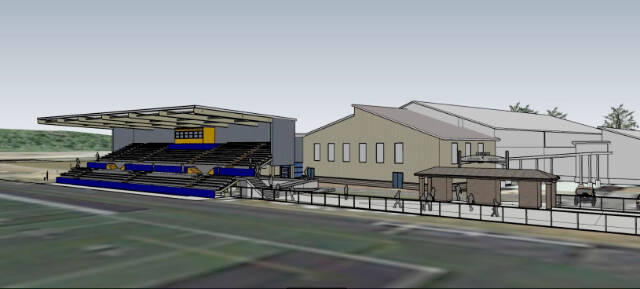FORKS — The replacement of Spartan Stadium finally is in the works.
“It’s been 13 years in the making,” said Quillayute Valley Superintendent Diane Reaume in Forks.
“We are in a fortunate position financially and logistically to make this happen in the current school year,” she said.
The district has budgeted $2.3 million in its capital projects fund for Phase 1 of the replacement of the 54-year-old stadium. The school board recently transferred local timber dollars from the debt service fund and general fund to pay for the first phase.
Work will begin the middle of this month with the demolition of the stadium built in 1962. A 1,136-seat modular steel and aluminum structure with a three-room press box will be delivered in late June.
The first phase also will include civil and electrical engineering, as well as a ticket booth and walkway improvements.“We recognize the inconvenience for our spring sports programs of FHS Track and Field, as well as boys’ soccer,” Reaume said of the gap between demolition and replacement.
“However, we have scheduled the specifics of the project so that we can still have home-scheduled events safely. Spartan fans will be without covered seating, but will sit on aluminum seats,” she said.
The stadium is being purchased through King County Directors’ Association (KCDA), a purchasing cooperative owned by Washington’s public school districts.
The present stadium is deteriorating to the point that concrete and steps are not safe, especially for elderly people who want to watch the sports teams compete, Reaume said. The stadium also lacks handrails and has poor egress to seating.
Many “have not been able to attend events due to safety issues,” Reaume said.
The public rejected a bond measure the district floated in 2008 that was two-pronged, funding work on the Forks High School and the stadium, Reaume said.
When the district presented a bond to the voters again, at the next opportunity, it cut it down to fund only the school work.
The stadium replacement had been discussed ever since, Reaume said.
“We finally put a 20-year facilities plan together so we could start talking to the community about long-term projects,” she said.
Prior to COVID-19 hitting in March 2020, the district formed a committee of community residents who guided the district in forming a vision for the stadium project.
“Our committee members worked diligently with our architects to create the current vision for the design and layout of our project,” Reaume said.
“The last committee meeting we held was on March 11, 2020, and we were ready to take the concept and details of the stadium to the board for their approval and to seek funding for the project.
“And then we were faced with a shut-down due to COVID-19.
“Everything came to a complete stop.”
COVID-19’s halt to activity proved to be something of a blessing, she said, since it allowed logging money to accumulate to in the debt service fund
“Otherwise, we would have had to figure out a capital projects fund or a levy,” she said.
Said Board Chairman Bill Rohde: “If we waited until the next school year, we would be faced with escalating prices and possible supply chain issues.
“We are within a short window of time to make this happen,” he added.
Phase 2, which is scheduled to occur in the 2022-23 school year, will entail the building of restrooms in a separate building adjacent to the stadium and such site improvements as fencing and asphalt/concrete improvement around the facility.
“We already were scheduled to replace old fencing with local levy dollars and will apply for a state grant to pay for a portion of Phase Two,” Reaume said.
The local logging industry has been a huge plus for the district throughout the past four years, she said.
“If we didn’t have a debt for the building of the 2012 Forks High School Addition, we would not be able to capture the funds from local state logging in the school’s junior taxing district,” she said.
In tracking these local timber sales, the undesignated unreserved local funds have accumulated over $2 million in the past four years, which are now designated for Phase 1 of the project.
“We can only utilize those dollars for construction or capital projects,” Reaume said.

